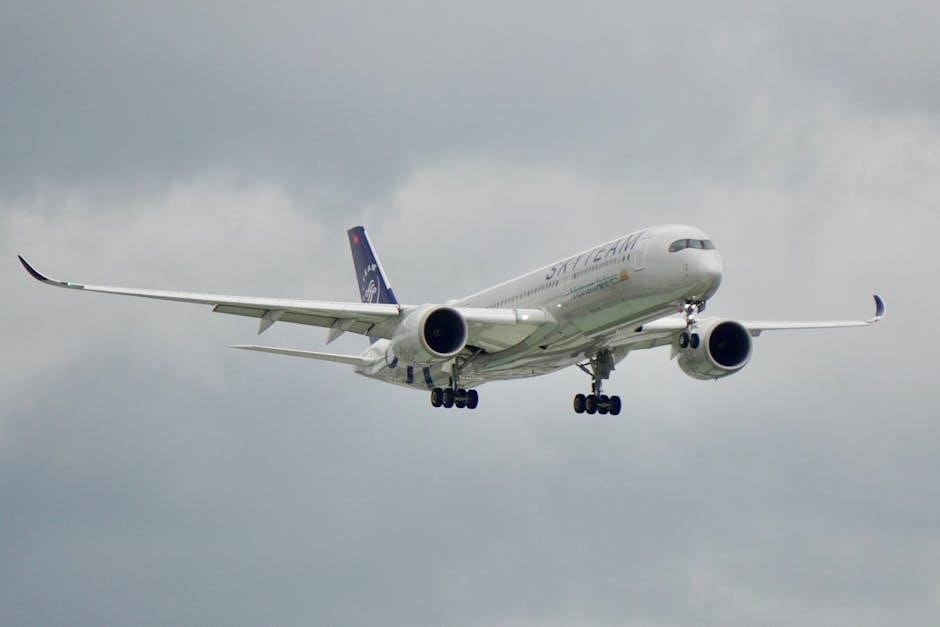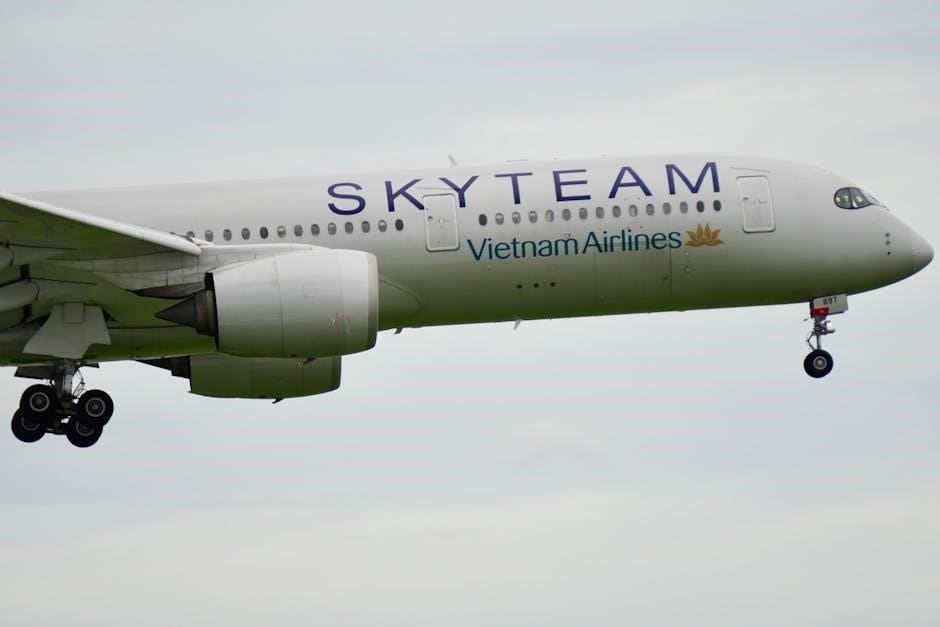The NATOPS Flight Manual provides standardized procedures and guidelines for U.S. Navy and Marine Corps aircraft operations, ensuring safety and effectiveness in various flight environments.
1.1 Definition and Purpose of NATOPS
The NATOPS (Naval Aviation Training and Operations Support) Flight Manual is the standard flight manual for U.S. Navy and Marine Corps aircraft. Its primary purpose is to provide standardized procedures, checklists, and guidelines for the safe and effective operation of naval aircraft. NATOPS ensures consistency across all aviation units, covering normal and emergency procedures, performance data, and aircraft-specific instructions. It serves as the authoritative reference for pilots, aircrew, and maintainers, ensuring compliance with established safety and operational standards. The manual is a controlled document, managed by COMNAVAIRFOR, and is updated regularly to reflect operational experiences and technological advancements. While NATOPS is non-classified, access is restricted to authorized personnel to maintain operational security.
1.2 History and Evolution of NATOPS Manuals
The NATOPS Flight Manual has its roots in the All-Weather Flight Manual, a precursor used for night and instrument meteorological conditions. Over time, NATOPS evolved to standardize procedures for all naval aircraft operations. Initially developed to address the complexities of post-World War II aviation, NATOPS became a cornerstone of naval aviation training and operations. The manual has undergone numerous revisions to incorporate advances in technology, aircraft design, and operational lessons learned. Managed by COMNAVAIRFOR, NATOPS ensures consistency across the fleet, providing a unified framework for safety, efficiency, and compliance. Its evolution reflects the Navy’s commitment to adapting to changing operational demands while maintaining the highest standards of aviation excellence.
1.3 Importance of NATOPS in Naval Aviation
NATOPS is indispensable to naval aviation, providing standardized procedures that ensure safety, efficiency, and regulatory compliance. It serves as the primary reference for pilots, guiding flight operations under various conditions. By outlining normal and emergency procedures, NATOPS enhances crew preparedness and decision-making. Its standardized protocols reduce operational risks, fostering a culture of safety and professionalism. Compliance with NATOPS ensures aircraft are operated within performance limits, protecting both personnel and equipment. Additionally, it supports training programs by offering clear, consistent guidelines. In emergencies, NATOPS provides critical checklists and contingency plans, enabling effective crisis management. Its importance extends to maintaining fleet readiness and operational excellence, making it a cornerstone of naval aviation success.
Structure and Content of NATOPS Manual
The NATOPS manual is a comprehensive guide containing standardized procedures, performance data, checklists, emergency protocols, and reference materials, organized into clear sections for easy access and adherence.
2.1 Standard Sections of the Manual

2.2 Chapter Breakdown and Key Topics
The NATOPS manual is organized into chapters, each addressing specific aspects of aircraft operations. Key topics include normal and emergency procedures, performance data, and aircraft limitations. Chapters on normal procedures cover pre-flight checks, startup, taxi, takeoff, and landing. Emergency procedures detail responses to system failures, fire emergencies, and evacuation. Performance data chapters provide critical information on aircraft capabilities, including speed, altitude, and fuel consumption limits. Additional sections focus on navigation, communication, and instrumentation. Appendices offer reference materials such as conversion charts, abbreviations, and safety guidelines. This structured approach ensures pilots have comprehensive guidance for safe and effective flight operations under various conditions.
2.3 Appendices and Reference Materials
The NATOPS manual includes appendices and reference materials that provide supplementary information critical for flight operations. These sections include checklists, conversion charts, and safety guidelines. Appendices often contain detailed procedures for specific scenarios, such as emergency landings or system malfunctions. Reference materials may include abbreviations, acronyms, and definitions to ensure clarity. Additionally, some appendices focus on aircraft-specific data, like performance graphs or configuration details. These resources are designed to complement the main chapters, offering quick access to essential information. Regular updates ensure the appendices reflect the latest operational practices and safety protocols, making them indispensable for pilots and aircrew. This supplementary content enhances the manual’s practical application in real-world scenarios.

Key Chapters and Sections
NATOPS manuals feature chapters on normal procedures, emergency protocols, performance data, and aircraft-specific instructions, ensuring comprehensive guidance for safe and effective flight operations across various scenarios.
3.1 Normal Procedures and Checklists
NATOPS manuals detail normal procedures and checklists for aircraft operations, ensuring standardized execution of tasks. These include pre-flight, start-up, takeoff, and landing procedures, with specific sequences and safety protocols. Checklists are designed to minimize errors, covering critical systems and configurations. For example, the T-39 Sabreliner NATOPS includes detailed pre-flight inspections and engine start procedures. Similarly, the F/A-18 Hornet manual outlines step-by-step processes for taxi, takeoff, and climb-out. These procedures are consistent across aircraft types, promoting uniformity and safety in naval aviation operations. Adherence to these guidelines is mandatory, as deviations can compromise mission success or aircraft integrity.
3.2 Emergency Procedures and Contingency Plans
NATOPS manuals include comprehensive emergency procedures and contingency plans to address critical situations. These procedures are designed to ensure pilot safety and aircraft recovery. Checklists for system failures, engine malfunctions, and other emergencies are provided, emphasizing quick and precise actions. For instance, the F/A-18 Hornet NATOPS outlines steps for handling hydraulic failures or cabin depressurization. Contingency plans also cover unexpected scenarios, such as navigational system outages or hostile environments. These guidelines are regularly updated to reflect operational experiences and advancements in aircraft technology. Pilots are trained to rely on these procedures to maintain control and achieve safe outcomes, even in the most challenging conditions.
3.3 Performance Data and Limitations
NATOPS manuals provide detailed performance data and operational limitations for aircraft. These sections outline maximum speeds, altitude ceilings, and payload capacities, ensuring pilots operate within safe parameters. For example, the EA-18G Growler NATOPS specifies thrust settings and climb rates. Limitations include temperature thresholds, G-force restrictions, and fuel consumption rates. Adhering to these guidelines prevents damage to the aircraft and optimizes performance. Updates are made based on flight testing and operational feedback, ensuring the data reflects real-world conditions. This information is critical for mission planning and execution, allowing pilots to make informed decisions during flight operations. Compliance with these limits is essential for both safety and aircraft longevity.
3.4 Aircraft-Specific Operating Instructions
NATOPS manuals include detailed, aircraft-specific instructions tailored to each model’s unique characteristics. For instance, the F/A-18 Hornet NATOPS outlines procedures for its advanced avionics and weapon systems. These instructions cover startup sequences, flight control configurations, and mission-specific checklists. The EA-18G Growler NATOPS focuses on electronic warfare operations, providing guidance on radar and jamming systems. Similarly, the T-39 Sabreliner NATOPS includes procedures for multi-engine operations and navigation. Each manual addresses aircraft-specific limitations and operational nuances, ensuring pilots can safely and effectively operate their assigned aircraft. These instructions are critical for both routine missions and specialized tasks, making them indispensable for aircrew training and operational success.
Regulatory Compliance and Updates
This section outlines the regulatory framework and update processes for NATOPS manuals, ensuring compliance with aviation standards and incorporating the latest operational guidelines and essential safety protocols.
4.1 Governing Bodies and Ownership
The NATOPS Flight Manual is owned and managed by COMNAVAIRFOR (Commander, Naval Air Forces), under the Department of the Navy. It is a controlled document, accessible to authorized personnel through official Navy channels. The manual is non-classified but subject to strict distribution protocols to ensure operational security and compliance. COMNAVAIRFOR oversees updates, revisions, and compliance with aviation standards, making it a critical resource for naval aviation operations. Access to the manual is facilitated through the Navy’s official website, ensuring that all personnel adhere to the latest guidelines and procedures.
4.2 Revision Process and Change Management
The NATOPS Flight Manual undergoes regular revisions to reflect operational requirements, technological advancements, and lessons learned. Updates are managed by COMNAVAIRFOR, ensuring accuracy and relevance. Interim changes are issued to address urgent modifications, which are later incorporated into the main manual. The revision process involves thorough reviews by subject matter experts, followed by approval from governing bodies. Each change is documented with version control to maintain clarity. This systematic approach ensures that all aircraft operations remain aligned with current standards and safety protocols. The manual’s adaptability to evolving needs underscores its critical role in naval aviation. Compliance with these updates is mandatory for all personnel.
4.3 Interim Changes and Incorporation
Interim changes provide immediate updates to the NATOPS Flight Manual, addressing critical issues before the next full revision. These changes are issued as separate documents, ensuring rapid dissemination. Each interim change includes details on implementation, effective date, and pages affected. Users must incorporate these updates promptly to maintain compliance. After a specified period, interim changes are consolidated into the main manual during scheduled revisions. This process ensures continuous improvement and alignment with operational needs. Proper incorporation of interim changes is verified through audits and inspections, reinforcing accountability and safety. This method allows the NATOPS manual to stay current with evolving aircraft systems and procedures, supporting effective flight operations.

Training and Operational Use
NATOPS manuals are integral to pilot training, providing standardized procedures for safe and effective aircraft operation. They guide routine and emergency protocols, fostering consistent performance across naval aviation.
5.1 Role in Pilot Training and Certification
NATOPS manuals play a central role in pilot training and certification by providing standardized procedures, checklists, and performance data. They ensure consistency in training, emphasizing safety and operational excellence. Pilots rely on NATOPS for pre-flight, in-flight, and post-flight procedures, aligning their practices with established guidelines. The manual serves as a foundational resource for both initial and recurrent training, reinforcing critical skills and knowledge. Adherence to NATOPS is a certification requirement, ensuring pilots meet rigorous competencies. By integrating NATOPS into training curricula, the Navy maintains high standards of aviation proficiency, preparing pilots for real-world scenarios while minimizing risks. This structured approach fosters a culture of compliance and operational readiness.
5.2 Application in Flight Operations
NATOPS manuals are integral to flight operations, providing detailed procedures for safe and effective aircraft handling. Pilots use NATOPS for pre-flight checks, startup, takeoff, and landing protocols, ensuring adherence to standardized guidelines. The manual outlines normal and emergency procedures, such as engine failures or system malfunctions, enabling crews to respond decisively. Performance data and limitations are critical for optimizing flight efficiency and safety. NATOPS also covers specific aircraft configurations and mission requirements, tailoring operations to diverse scenarios. By following NATOPS, pilots maintain operational consistency and compliance, reducing risks and enhancing mission success. Its practical application ensures that flight operations align with Navy and Marine Corps aviation standards, fostering a culture of safety and professionalism.
5.3 Integration with Other Manuals and Doctrine
NATOPS manuals are designed to integrate seamlessly with other operational documents and military doctrine, ensuring a cohesive approach to flight operations. They align with tactical manuals, such as the Air Force’s 11-2 series, to provide a unified framework for joint operations. This integration ensures consistency in procedures, checklists, and emergency protocols across different aircraft and branches. NATOPS also complements mission-specific doctrine, adapting to various operational scenarios while maintaining standardized practices. By harmonizing with other manuals, NATOPS enhances operational efficiency, safety, and interoperability. This integration is critical for maintaining a unified and effective approach to military aviation, ensuring that all personnel operate under the same guidelines and principles.

Specific Aircraft Manuals
NATOPS manuals are tailored for specific aircraft, such as the F/A-18 Hornet, EA-18G Growler, and T-39 Sabreliner, providing detailed procedures and guidelines unique to each airframe.

6.1 F/A-18 Hornet NATOPS Manual
The F/A-18 Hornet NATOPS manual offers comprehensive operational guidelines for this multirole fighter, detailing normal and emergency procedures, aircraft performance data, and specific flight instructions tailored to its advanced systems. It ensures pilots can operate safely under various conditions, adhering to strict compliance standards. The manual is regularly updated to reflect new tactics and technological advancements, making it an indispensable resource for both training and active-duty pilots. Its structured format includes checklists, performance charts, and emergency contingency plans, providing clear guidance for all aspects of Hornet operations. This manual is crucial for maintaining operational excellence and safety in naval aviation.
6.2 EA-18G Growler NATOPS Manual
The EA-18G Growler NATOPS manual provides detailed operating procedures for the U.S. Navy’s electronic warfare aircraft, focusing on its unique mission requirements. It outlines normal and emergency procedures, performance data, and specific electronic warfare tactics. The manual emphasizes the aircraft’s advanced systems for jamming and electromagnetic warfare, ensuring pilots can execute missions effectively. Regular updates incorporate new technologies and tactics, keeping the manual aligned with evolving operational needs. It includes checklists, emergency contingency plans, and system-specific instructions, making it essential for both training and operational use. Compliance with this manual is critical for maintaining safety and operational excellence in electronic warfare missions.
6.3 T-39 Sabreliner NATOPS Manual
The T-39 Sabreliner NATOPS manual is tailored to the specific operational needs of this versatile aircraft, which serves roles ranging from training to logistics support. It provides standardized procedures for safe and effective flight operations, ensuring consistency across all pilots and crew members. The manual includes detailed checklists for pre-flight, in-flight, and post-flight procedures, as well as emergency protocols tailored to the T-39’s systems. Performance data and limitations are clearly outlined to optimize aircraft performance under various conditions. Additionally, the manual incorporates training guidelines, making it an essential resource for both new and experienced pilots to maintain proficiency. Compliance with this manual is crucial for operational safety and mission success.

Digital Access and Distribution
The NATOPS manual is accessible online through official Navy platforms, ensuring ease of access for authorized personnel while maintaining security and controlled distribution protocols.
7.1 Online Availability and Accessibility
The NATOPS Flight Manual is accessible online through official U.S. Navy platforms, ensuring ease of access for authorized personnel. These digital versions are regularly updated to reflect the latest operational guidelines and safety protocols. The manuals are typically hosted on secure, password-protected websites to maintain confidentiality and comply with military regulations. Access is restricted to authorized military personnel, contractors, and partners with valid credentials. The digital format allows for quick reference and search functionality, enhancing operational efficiency. Additionally, the manuals are optimized for viewing on various devices, including desktop computers, tablets, and mobile devices, making them accessible in diverse operational environments. This digital accessibility supports timely decision-making and adherence to standardized procedures.
7.2 Classification and Controlled Distribution
NATOPS Flight Manuals are classified as nonclassified controlled documents, ensuring their distribution is restricted to authorized personnel. Access is limited to military personnel, contractors, and partners with a verified need-to-know. These manuals are not classified but contain sensitive operational information, requiring controlled dissemination to prevent unauthorized use. Distribution is managed through secure channels, with digital versions requiring authentication and official clearance. Hard copies are similarly restricted, issued only to authorized individuals or units. This controlled distribution ensures that critical flight procedures and safety protocols remain protected while being accessible to those who require them for operational duties. The Navy emphasizes the importance of adhering to these restrictions to maintain operational security and integrity.
7.3 Digital Formats and Viewing Requirements
NATOPS Flight Manuals are available in digital formats, primarily as PDF documents, to ensure accessibility and ease of use. These files are optimized for viewing on various devices, including tablets and laptops, which are commonly used in flight operations. Specific software, such as Adobe Acrobat, may be required to access and annotate the documents. The manuals are regularly updated to reflect operational changes, and users are encouraged to verify the version date to ensure they have the most current information. Digital versions often include interactive features like bookmarks and search functionality to enhance usability. Security measures, such as encryption and watermarks, are implemented to protect sensitive content. Users must adhere to distribution guidelines to maintain document integrity and security.

Practical Applications and Case Studies
NATOPS manuals are applied in real-world flight scenarios, providing critical checklists and procedures for pilots to follow during emergencies and routine operations, enhancing safety and efficiency.
8.1 Real-World Scenarios and Checklists
NATOPS manuals are indispensable in real-world flight scenarios, offering detailed checklists and procedures for emergency situations, such as system malfunctions or in-flight emergencies. Pilots rely on these standardized protocols to ensure safe and efficient operations. For instance, during an unexpected loss of cabin pressure, NATOPS provides step-by-step actions to stabilize the aircraft and protect the crew. Similarly, pre-landing checklists are meticulously outlined to minimize risks. These practical applications emphasize the importance of adhering to NATOPS guidelines, as deviations can lead to critical errors. Real-world case studies highlight how these manuals have prevented accidents and improved operational outcomes, underscoring their vital role in naval aviation safety and efficiency.
8.2 Lessons Learned from Operational Experience
NATOPS manuals are continually refined based on operational experiences and lessons learned from real-world flights. These updates ensure that pilots benefit from the collective knowledge gained over time. For example, feedback from fleet operations has led to revisions in emergency procedures, enhancing safety and efficiency. Specific instances, such as the EA-18G NATOPS manual updates, demonstrate how operational insights shape manual improvements. These lessons emphasize the importance of adhering to standardized procedures and highlight the critical role of continuous improvement in naval aviation. By incorporating real-world experiences, NATOPS manuals remain a cornerstone of safe and effective flight operations, preventing recurring issues and promoting operational excellence.
8.3 Application in DCS and Flight Simulation
NATOPS flight manuals are widely used in Digital Combat Simulator (DCS) and flight simulations to enhance realism and accuracy. They provide detailed procedures, checklists, and performance data that mirror real-world operations. For example, the F/A-18 Hornet NATOPS manual is often referenced by DCS players to accurately model aircraft behavior and tactics. Similarly, the EA-18G Growler NATOPS manual aids in simulating electronic warfare scenarios. These manuals enable enthusiasts to replicate authentic military flight procedures, making simulations more immersive and educational; The community frequently adapts NATOPS guidelines to create realistic missions and training exercises, ensuring a high level of fidelity in virtual aviation experiences. This application underscores the practical value of NATOPS beyond its official military use.
Compliance and Accountability
Compliance with NATOPS guidelines is crucial for accountability. Non-compliance can lead to severe consequences, including safety risks and operational failures. Regular audits ensure adherence to procedures.
9.1 Adherence to NATOPS Guidelines
Adherence to NATOPS guidelines is essential for maintaining operational integrity. Pilots and aircrew must strictly follow procedures outlined in the manual to ensure safety and efficiency. Non-compliance risks accidents and compromises mission success. Regular training and recurring checks reinforce the importance of these standards. The manual serves as the primary reference for all flight operations, providing clear directives for normal and emergency procedures. By adhering to NATOPS, personnel uphold the highest standards of naval aviation, minimizing risks and ensuring effective mission accomplishment under all conditions.

9.2 Consequences of Non-Compliance
Non-compliance with NATOPS guidelines poses serious risks to flight safety and mission success. Deviations can lead to accidents, equipment damage, and loss of life. Personnel found in violation may face disciplinary action, including loss of flight privileges. Additionally, non-compliance undermines operational readiness and trust within the squadron. Audits and inspections identify such lapses, ensuring accountability. Repeat offenses may result in mandatory retraining or separation from duty. The Navy emphasizes strict adherence to NATOPS to maintain its reputation for excellence and safety in aviation operations. Consequences extend beyond individuals, affecting the entire unit’s effectiveness and reputation.
9.3 Audit and Inspection Processes
Audit and inspection processes ensure compliance with NATOPS guidelines through regular, thorough evaluations. Trained personnel conduct these assessments to verify adherence to operational procedures, maintenance protocols, and safety standards. Inspections may involve reviewing flight logs, maintenance records, and procedural checklists. Any discrepancies are documented and addressed promptly to maintain operational integrity. These processes also identify trends or systemic issues, enabling corrective actions. Audits may be conducted at various levels, from squadron inspections to higher command evaluations. The goal is to ensure accountability, safety, and mission readiness, while fostering a culture of continuous improvement within naval aviation operations.
The NATOPS Flight Manual is a critical resource for naval aviation, ensuring safety and operational excellence. References include the NATOPS manual itself and related aviation doctrine.
10.1 Summary of Key Points
The NATOPS Flight Manual is a comprehensive guide for U.S. Navy and Marine Corps aircraft operations, emphasizing safety, standardization, and compliance. It covers normal and emergency procedures, performance data, and aircraft-specific instructions, ensuring pilots operate effectively in various environments. Regular updates maintain accuracy and relevance. The manual is indispensable for pilot training and certification, integrating with other aviation doctrine. By adhering to NATOPS guidelines, pilots uphold operational excellence and mitigate risks. Its digital accessibility and controlled distribution ensure widespread availability while maintaining security. The NATOPS Flight Manual remains a cornerstone of naval aviation, reflecting the Navy’s commitment to operational readiness and safety. References include the NATOPS manual itself and related aviation regulations.
10.2 Recommended Reading and Resources
For further understanding, the NATOPS Flight Manual is complemented by aircraft-specific manuals like the F/A-18 Hornet and EA-18G Growler NATOPS guides. Additional resources include the BFM training manual and Chuck’s Guides, which simplify complex procedures. The NAVAIR 00-80T-112 Integrated Fighting Forces Manual provides supplementary operational insights. These documents are accessible online, offering detailed aircraft performance data and tactical procedures. Pilots benefit from cross-referencing these materials to enhance their knowledge and operational proficiency. These resources are essential for both new and experienced aviators, ensuring comprehensive understanding of naval aviation standards and practices. They are readily available for download, supporting continuous learning and operational excellence in naval aviation.

10.3 Final Thoughts on NATOPS Importance
The NATOPS Flight Manual is a cornerstone of naval aviation, ensuring operational excellence and safety. Its standardized procedures and guidelines are critical for mission success, fostering consistency across all aircraft operations. By adhering to NATOPS, pilots and aircrews maintain peak performance and readiness. The manual’s adaptability to evolving aviation challenges underscores its enduring relevance. Continuous updates reflect advancements in technology and operational demands, making it indispensable for modern naval aviation. Ultimately, NATOPS embodies the commitment to excellence and safety that defines U.S. naval aviation, serving as a vital resource for achieving operational goals effectively and efficiently.
